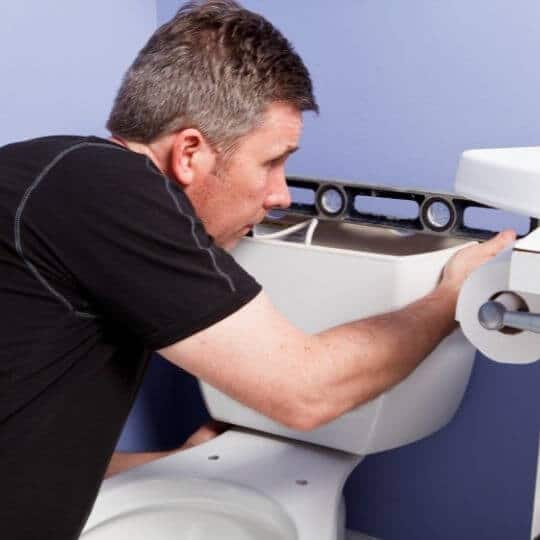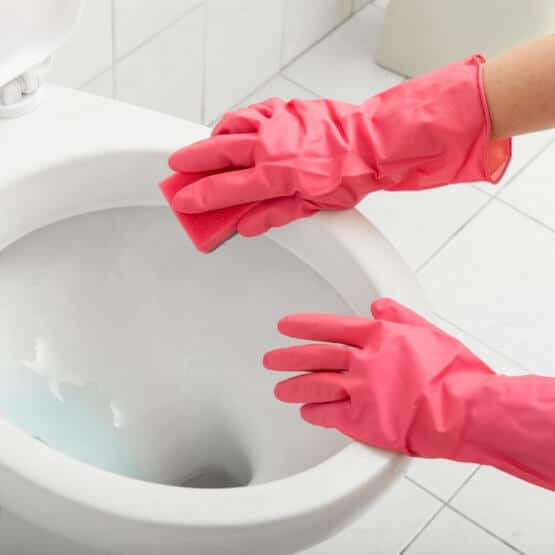Also known as the macerating toilet, an upflush toilet is one of those fixtures designed to simplify everyday life.
It is the best option if your bathroom is too far from the main drain line.
Upflush toilets are not only efficient, but they also tend to save up money in the long run. However, every fixture comes with its downsides.
The best thing to do is to always compare the pros & cons of a certain product before investing in it.
Continue reading about the pros & cons of upflush toilet to find out if this product is right for you.
Pros and Cons of Upflush Toilet To Consider Before Installation

Whether or not you decide to install an upflush toilet will largely depend on the location of the installation.
To discuss the perfect location suited for this fixture, first, let’s shortly discuss how an upflush toilet even works.
So, how does an upflush toilet work?
Customers and users don’t really notice any difference between an upflush toilet and other toilets. This is because the only major difference is what happens with the waste after you flush.
Most flushing systems use gravity or pressure-assisted mechanisms. The only difference is – macerating toilets send waste down into the unit behind a wall after flushing.
This unit is called a pump and is the most important part of any upflush toilet. In this container, the waste gets shredded by a blade and then pumped up into the existing main drain line.
This pump is sometimes behind a wall, with an extension pipe connecting it to a toilet bowl. Other times. it is just sitting behind a toilet as a unit.
This allows for upflush toilets to be installed even in areas below the main drain line, as they don’t rely on gravity. Areas such as basements, off-the-grid homes, or even sailing boats can have this type of toilet!
Now that you know the basics, let’s further discuss the pros & cons of upflush toilet.
PROS
- Off-the-grid location – The one big advantage to upflush toilets is the possibility of installation in places far from the main drain line. In fact, it can pump the effluent up to 15 feet vertically and up to 150 feet horizontally. [1]
- Portability – An upflush unit is easy to install, and therefore possible to move and relocate if needed – just by unscrewing a few bolts!
- Durability – Upflush toilets have a long lifespan of about 10-15 years, or even longer if maintained properly.
- They save money in the long run – Installing the upflush toilets saves you money in different ways. Upflush toilets tend to be more water-efficient, which saves up on your water bills. You will pay much more with buying a traditional toilet and hiring a plumber (aka for average bathroom installation).
- Can be attached to other sanitary ware – Macerating toilet system typically allows you to attach to an existing drainage system, which reduces the cost of installation.
- Aesthetics is not compromised – There is barely any difference in the look and the comfort of macerating toilets compared to the other traditional toilets.
- Low maintenance – Maintenance typically includes only replacing the pump every 10 years or so. There are other small ways in which you can maintain this toilet (more on that later!)
CONS
- Higher initial cost – It may sound contradictory, but upflush toilets can be also more expensive upfront, especially if you’re buying a well-known brand.
- Noise – The shredding of the waste in the pump can definitely cause some noise. There are certainly some locations where this is not as suitable as an option.
- You’ll need electricity – Power cuts can definitely be a problem for a macerating toilet, as it uses electricity in order for the pump to work properly.
- Can get overworked – These toilets are not recommended for frequent use by a large number of people, as the pump can fail if overworked.
Upflush Toilet Maintenance

Now that you are more familiar with the pros & cons of upflush toilet toilet, let’s discuss the maintenance.
Luckily, an upflush toilet doesn’t require any special maintenance, other than replacing the pump every 10-15 years.
However, there are some things you can do to ensure the longevity of your toilet and also keep the upflush system in check. If you are unsure how to clean or unblock an upflush toilet, read on!
How To Clean An Upflush Toilet?

The outside of your macerating toilet is cleaned the same way you would clean other traditional toilets. This includes removing the black streaks, calcium deposits, or limescale.
However, it’s also important to note that the crucial part of any upflush toilet is the pump (or the macerator).
In order to clean this part, first, make sure to turn off the power that leads to the macerator itself. The switch will be somewhere behind a toilet or on a unit. It all depends on where it is placed and on the manufacturer.
Pour the toilet bowl cleaner into the bowl. You can also use the descaler made for the macerator.
Next, turn on the macerator again to allow the cleaner to get into the macerator. Then turn it off again and leave it for 2-3 hours.
Don’t use the toilet during this time. This should allow the cleaner to decompose and break up any scum and deposits that are inside the macerator.
Finally, after a few hours have passed, reconnect the power supply to the macerator and flush the toilet. And – you’re done!
How To Unblock An Upflush Toilet?

It’s possible for an upflush toilet to get blocked if overused, as the pump itself can fail. Also, flushing non-flushable products can block any toilet, not just this one.
Unblocking a macerating toilet takes more time and equipment, as you’ll probably need to open the units to find the blockage.
To do so, make sure to use protective gloves and clothes. [3]
Depending on the fixture, you might need to loosen the pipe connected to a wall or open the unit itself.
After finding the blockage, it’s fairly easy to just remove it. The final step is to reconnect the unit back to its place.
Be careful and work with the right amount of equipment as your body could come in contact with solid waste. Make sure to ask a friend or a professional for help.
IMPORTANT NOTE: You could void the warranty of the upflush toilet if you repair it yourself. If your toilet is still under warranty, make sure to consult a professional to remove the blockage.
FAQ
Do I Need To Clean My Upflush Toilet?
General cleaning of the toilet is necessary for maintaining the hygiene of the bathroom. Other than that, the macerator can work just fine without any additional cleansing.
Do Upflush Toilets Smell Bad?
Even though the pump dissolving the waste is fairly close to the toilet, there should be no bad smells coming out. If there are, make sure to clean the toilet bowl. If you still notice a bad smell, it may be a septic tank smell.
Sewage Ejector System VS Upflush Toilet?
A sewage ejector system is placed when a fixture exists below the main drain line – the same goes for upflush toilets. The difference: permit requirements and making a mess with improper installation.
You’ll need to know the size of the sewer pump needed beforehand. Also, you’ll need to consult a plumber if additional work is to be done on the main sewer line.
My Upflush Toilet Won’t Stop Flushing?
This is a minor problem, typically connected to the loosening of the rubber membrane. This rubber sheet, when damaged, can cause endless flushing. Make sure to ask for a replacement if still under warranty period.

Michael Davis is a heating & plumbing expert who currently works as independent contractor in SC. He also writes for Plumbertip.
For almost 10 years he worked on various plumbing tasks across South Carolina.


